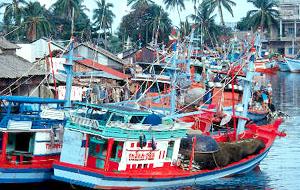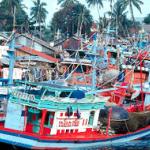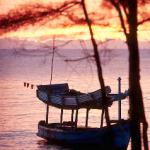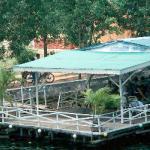Rock Around the Quoc
A string of beach resorts with no street vendors? No touts, no hustlers, no cold drink and souvenir sellers?
Amazingly enough, such a string of beaches still exists on planet Earth. The scene is Vietnam's Phu Quoc Island, in the Gulf of Thailand, nearly on the Vietnam/Cambodia border.
Phu Quoc Island, in Vietnam's Kien Giang province, is about the same size as Singapore, with a population of 75,000 that swells to around 120,000 in the dry season, when fishermen from Da Nang descend on the island to exploit the rich catch. There were those who wanted turn the island into a clone of Singapore, with large tracts of land marked out for industrial development. But fortunately, such a prospect seems to have been nipped in the bud, with nearly 70% of the Island being declared a National Park at the beginning of March 2001.
Le Hung Vi, who grew up on Phu Quoc Island, counts himself lucky indeed. As the youthful proprietor of Phu Quoc's first "Internet Café" (a sophisticated computer set-up in his home bedroom), he seems to be on the road to fame and riches... all without leaving his island "paradise". If Vi's resourcefulness is any indication of Phu Quoc's prospects, then the future for tourism here seems rosy indeed.
Tourism development on Phu Quoc is just starting to take off, with the island's many clean and safe beaches easily outdoing anything that Bali has to offer. The most accessible and one of the most attractive is Truong Beach, covered with buttermilk-creamy sand, stretching for nearly 20 km from Dinh Cau (just out of Duong Ðong town) to Khoe Tau Ru. In the south-east, Bai Kem ("Icecream Beach") has superfine white sand. It is said that in bygone days this beach was the exclusive province of wealthy aristocrats.
Just this year (2001), three international hoteliers have been granted permits to build on Truong Beach. For now, visitors have the choice of staying at the townside Hoang Bien (popular with weekenders from Saigon, and with its own small but very clean beach), or at one of four other resorts, which decrease in price and variety of creature comforts the further you get from town.
I initially take a room at the classic Kim Linh Hotel, Phu Quoc's very first beach resort. Amidst the faded glory of a 60s concrete block complex (fortunately still clean and comfortable inside), I make acquaintances with the Vinh family, who still carry on the traditional island ways of life. While the ladies and little girls of the family are sorting green peppercorns, the guys are out fishing. Later, the whole family will help to reel in the nets, using a foot-pedal winch that is unique to Vietnam. The result is a rich harvest of prawns, crabs, calamari and ocean fish, which will later grace the tables of the family's beachside restaurant.
Moves are now afoot to refurbish the Kim Linh Hotel, with the additional of some beachside bungalows that should soon restore the hotel to its former pride of place. But upstaging the Kim Linh just for now are three newer beachside hotels, each with its own distinct charms. Top of the line (and nearest to the waterfront town of Duong Ðong) is the Phu Quoc Saigon, a new place calling itself three-star but more like a four-star resort, with a large boomerang-shaped swimming pool (which, sadly, is rather poorly maintained) overlooking a splendid beach. Catering more to local guests (and also German tour groups) is the similarly new Kim Ho Resort, and further south again (just before the Kim Linh) the superbly designed Tropicana Resort, complete with windsurfers and boats for hire.
I have the privilege of dining at Phu Quoc's most (deservedly) popular restaurant, "Hieu's Place", a family-run establishment right on the beach, between the Kim Linh and the Tropicana. Fish is (naturally enough) the specialty of the house - and this is fish like you've never tasted before. Steamed squid with the colour of lotus flowers and the delicate texture of rice-paper. Blue swimmer crabs cooked in a tangy ginger sauce. King prawns sautéed with lemongrass and chilli. Plus stir-fried vegetables, rice and condiments. For three of us the bill, including ample quantities of beer, comes to 170,000 dong (about $M46 or $US12).
The tracks of Phu Quoc are mainly well-maintained dirt roads, but tree-lined, palm-lined and bamboo-lined. The clearings between the houses are lush and fertile; the houses themselves ranging from simple wooden structures to lavish new whitewashed villas, all with the obligatory TV aerial on a bamboo pole. In the gardens are ancestral tombs, each emblazoned with a red symbol resembling an oriental fleur-de-lys.
I rent a motorbike to do some exploring. The bikes on hire are no great road-churners, but modest steeds like the Honda Dream Machine, or similar. With a bike, I feel as though in Explorers' Heaven, freed from the straitjacket that generally goes under the name "tourism product".
South of the Kim Linh Hotel, Truong Beach peters out into a narrower but still sandy strip. Perched right on the beach is the headquarters of Phu Quoc Pearls, a joint Australia-Vietnam venture farming pearls in the An Troi Islands south of Phu Quoc. The showroom is already starting to attract visitors.
Back in the 1970s, the road from Duong Ðong to An Troi was strictly no-go territory. Van Hung Nguyen, who was born in Duong Ðong and now owns a restaurant in Byron Bay (Australia), remembers this time well.
"The Viet Cong had mined the centre of the island during the War", he says. "To protect Duong Ðong, the South Vietnamese army built a 5 km radius barbed-wire fence right around the town."
Van Hung is one of the lucky ones. He escaped to Cambodia and spent most of the war there, returning to Vietnam only when Pol Pot came to power. Then, twelve days later the Viet Cong marched into Saigon, and Van Hung fled once again. "I lost two countries in two weeks", he says.
For a brief period in 1975, Phu Quoc's population swelled to 300,000, as forces still loyal to the South Vietnamese government took refuge on the island. The barracks in which they were housed can still be seen near the crossroads north of An Thoi. But it wasn't long before the victors of the War took control of Phu Quoc, with the refugees forced to flee once again or return to the mainland.
Today, the south of Phu Quoc Island is quiet. The dirt road from Duong Ðong is still dirt. But then... total amazement! The tan of the dirt becomes bitumen-black, and palatial new buildings line the roadside. This is the outskirts of An Troi town, a bustling seaport that before the completion of Duong Ðong airport was the most important town on Phu Quoc An Troi is bigger, noisier and more crowded than Duong Ðong, but by contrast is totally unphotogenic - unless, that is, it is possible to photograph the smell of rotting fish.
The An Troi islands, off the southern tip of Phu Quoc, are popular for fishing and snorkelling day-trips. But sadly, the corals around the reefs have been nearly totalling destroyed by dynamite used in "fishing", while native species such as the dugong and green turtle have been hunted to the point of extinction (the last dugong seen in these waters was killed last year). But all is not lost - it is hoped the with the creation of the An Troi Marine Park as part of the Phu Quoc National Park program, marine life will begin to return.
However, the beaches just north of An Troi are something else again. Top of the must-visit menu is the aforementioned Bai Kem beach.
Getting to Bai Kem is half the "fun". Just off the road, about 11/2 km north of An Troi, is a military base. As it turns out, the guard post is something of a façade. In fact, the track to Bai Kem runs right THROUGH the base. I felt unnerved to be surrounded by troops going about their daily duties, but was given to understand that it was OK to ride through to the beach.
Bai Kem amply rewards the efforts needed to get there. The only purer-white beach I've seen is Whitehaven, in Queensland's Whitsunday Islands - and it's a close call indeed. As at Whitehaven, the custodians of Bai Kem seem so knocked out by the beauty of the place that development will most likely never be permitted.
A more accessible beach (thought the tracks are still bad) is Sao Beach, with a turnoff about 21/2 km north of the junction where the road from Duong Ðong leads south to An Troi or north to Cau Sau. The track down to the beach runs through shady groves of cashew-nut trees. The beach itself is just about as good as Bai Kem, and has the added bonus of hammocks where you can rest in oriental style under the palms.
However, the north of Phu Quoc Island is possibly of more interest to the visitor than the south. The north contains stands of some of the last remaining lowland rainforest in Vietnam, similar to that found in the Cardamom Mountains of Cambodia. On a clear day, you can see from the mini-mountains of the north right across to the hills of Sihanoukville, in Cambodia.
The road to the north from Duong Ðong town passes across the northern end of the airport runway (which the locals use as a drag strip) and past the imposing and sobering Phu Quoc War Cemetery. Past a Chinese temple, a side-road leads to Thang Loi beach, where some modest bungalows are currently under construction. Further along, a Y-junction leads NW top Cua Can or NW to the mountains.
The village of Cua Can, on the picturesque Cua Can River, is where the Vietnamese national hero Nguyen Trung Truc holed up in 1861, after setting fire to the French warship Esperance. Nguyen, leader of the anti-French guerrillas, was hunted down and executed in 1868, but legends of his exploits are still passed down from generation to generation on Phu Quoc Island. Today, Cua Can is a quiet place, an important boat-building and fishing centre.
North of Cua Can the road bifurcates, then trifurcates and multifurcates. Needless to say, I got lost - several times over. But in losing something you gain something - whether it's the friendliness of the locals (including an impossible-to-refuse invitation to partake of the local firewater), or the pleasure of just cruising in the lee of densely forested mountaintops.
Phu Quoc Island is a forerunner of big things to come on the tourism agenda of Kien Giang province. Besides Phu Quoc, over a hundred big and small islands are scattered over a wide area. Other populated islands with favorable conditions for tourism development include Hon Tre, also called Hon Rua (as it is said to be similar to a turtle), 25 km by sea from the provincial capital Rach Gia; Hon Nghe island with abundance of jack fruit, mango and camellia trees; and the 30 sq km Son Rai or Lai Son Island. Thirty kilometres from Lai Son are the 20 islands of the Nam Du archipelago, the largest island being Cu Tron. Of special significance is the Hai Tac (Pirate) Archipelago, consisting of 16 islands in the Rach Gia Gulf. Some of these islands are said to contain troves of treasure buried by pirates in the 17th Century (don't give up your day job just yet).
In typically poetic Vietnamese style, a Kien Giang tourism brochure describes the flocks of white swallows that hover in the skies above the islands around Phu Quoc as "similar to cloud bridges connecting the islands together." As for myself, after a visit to Phu Quoc Island I'm still on Cloud Nine - and I'm fervently hoping that there will be more clouds to come.
* * * * *
Fact File
Getting There: Vietnam Airlines flies regularly from Los Angeles to Ho Chi Minh City (Saigon), via Taipei. Vietnam Airlines also flies daily except Thursdays from Ho Chi Minh City to Phu Quoc Island. The one-way fare is $US 45.
Accommodation:
Saigon Phu Quoc Resort: Room rates $US22-42; tel +84 77 846 999; fax +84 77 847 163; email sgphuquocresort@hcm.vnn.vn.
Kim Hoa Resort: Room rates $US15-25; tel +84 77 847 039; fax +84 77 846 144.
Tropicana Resort: very popular - advance booking essential; Room rates $US15-36; tel +84 77 847 127; fax +84 77 847 128.
Kim Linh Hotel: Room rate 120,000 dong ($US8 or $M30). Tel +84 77 846 611, fax +84 77 846 144.
Internet: in Le Giang Restaurant (289 Thi Tran, Duong Ðong, next to the big Sung Hung Co Tu Pagoda, tel +84 77 848 383; ask for Vi). Costs 2,000 dong ($M0.53) a minute because of high radiotelephone rates, but still 50% cheaper than its nearest competitor.
Guide-books: The Lonely Planet guide to Vietnam has a very useful section on Phu Quoc, though the more recent hotel developments are not covered.
Acknowledgments: The author visited Vietnam as a guest of Vietnam Airlines and Travel Indochina.
* * * * *
 ThingsAsian
ThingsAsian




















